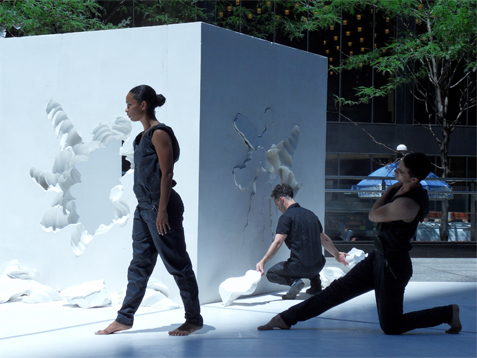|
 |
|
|
 |
 |
The corner outside Chase Bank headquarters at lunchtime was subsumed into an otherworld of art. Only the burger smell that emanated from the sidewalk vendor, with his blue and white (Chase colors) umbrella, recalled the generous owner of the patio. On a mezzanine level, the audience faced the black glass and steel of an adjacent building and the cattycorner concrete Stock Exchange building. The financial district backdrop provided both contrast and construct. Partway through the SITELINES midday dance by Judith Sánchez Ruiz, Jonah Bokaer, and Daniel Arsham July 10th, I had a lapse of memory. "Untitled Corner" drew me beyond the quotidien. It is an excerpt from "Replica," the hour-plus dance about memory loss commissioned by the National Academy of Science and seen at the Harman Center in DC July 1. Every showing has new meaning. Shadows, traffic noise, and other partners affect the outcome. Each site owns a footprint. Memories belong to every audience member. Both titles, "Replica" and "Untitled Corner," are perfectly descriptive and allow for imaginative flight. The site-specific work takes the viewer from futuristic space station or polar post-apocalypse, to above cloud cover. The dance looks naturalistic and removed from any technology that might have enabled or inspired the project. Arsham made sets for several Cunningham Company dances. There he worked independently and presented them complete. "This is collaborative in a different way," he said. Creating the piece with Bokaer and Sánchez was give and take. They met around the initial concept of the room-sized cube made of Styrofoam and plaster, and choreographers Bokaer and Sánchez's developing "corner" piece. "Untitled Cube" melds animate and inanimate forms in a poetic and evocative experience. Arsham's cube is a kind of phenomenological container, dividing inside, outside, life, and death. The top is open to the sky. The bright sun and breezy summer day, with strong contrasts of light and shadow are the unsung collaborators. The muffled traffic noise below backs up Alexis Georgopoulos's excellent original sound score. Its sustained tones are like a very musical, mellow car alarm. Silence and electronic arpeggios add to this varied and apt counterpart. Dressed in the same gray uniform, Bokaer lies on Sánchez's side in a pensive pose. Together, with identical moves, they negotiate the space in the front yard of the white cube. On three triangles of white Marley flooring, spliced with gray tape extending to the front corners, there are several astonishing leaps by Bokaer and a memorable off-kilter jump by Sánchez. Faces express both intense presence and curiosity. Arsham, wearing black, is inside the cube, having entered from an unseen opening at the back. He empties the wall of its removable breakout pieces, creating an anthropomorphic shaped opening. It recalls other works of Bokaer's in which he has used the chalked, crime victim outline. Here though, it is more than a symbol and can be processed directly. Importantly, it is central to this uncluttered work. Sánchez presented a solo work-in-progress, "Puzzle/Rompecabeza," in 2002 at The Kitchen, with an open room-sized cube made by Jonathan Crammer. She once said of her early years in Cuba, that for her, dance was "like a hole in the sky." The cube in "Rompecabeza" recalls that feeling of openness and freedom in dancing. So does Arsham's sculpture and the way the dancers relate to it. On the "stage" between the cube and the audience, Sánchez flies in an airplane lift supported by Bokaer. Sánchez's years in the Trisha Brown Company and Bokaer's years with Cunningham complement each other. For example, when she teeters or he leans into her, pressing his weight at her side. To cello music in the score she sways with an up and down rhythm, recalling her Latina influence. Her solo is fluid and musical. Yin and Yang. His energy is exterior. The dance's passion and inevitability draws us in. In a central section, he is puppet like and she drags him in a circular dance. He comes alive in profile, with Egyptian hands and a frieze-like walk. His is an atavistic/futuristic style. His sudden leaps, though, come out of nowhere, breaking the progression of earthbound moves. He enters the cube and takes her in. She does not go. Instead she "turns the corner" into a faltering solo. This is the very sad part. Where does one go after loss? She makes a little jump with her back arched, in a show of strength and individuality. Finally, are they above cloud cover? The work has a cloud-like ethereality to it. Partly that is the sun reflecting off the white and washing out the lines. From the dancers' entrances and exits through the plaster cutouts, they wear a fine chalk white dust. They could be miners or ghosts. The entrances and exits are the most striking. They disappear into the center, meeting in an enclosed space that suggests eternity. New Yorkers who haven't seen "Replica," if you wonder how this plays out in the full work, The New Museum has slated it for December.
 Judith Sanchez, Daniel Arsham, Johah Bokaer Photo © & courtesy of Lori Ortiz |
|
 Arsham Photo © & courtesy of Lori Ortiz |
|
 Bokaer and Ruiz Photo © & courtesy of Lori Ortiz |
|
 Sanchez and Bokaer Photo © & courtesy of Lori Ortiz |
|
 Untitled Corner
Courtesy of Lower Manhattan Cultural Council Photo © & courtesy of Douglas Back |
|
|
|






